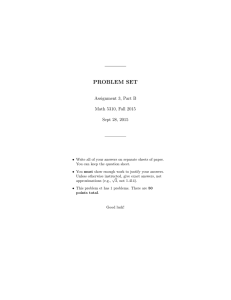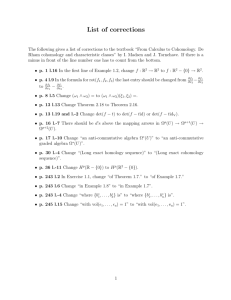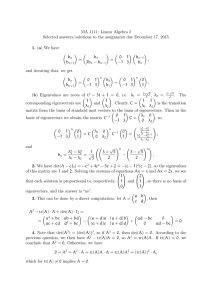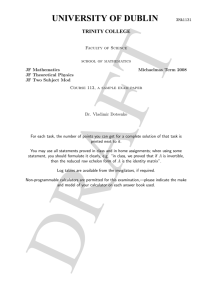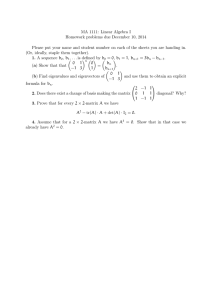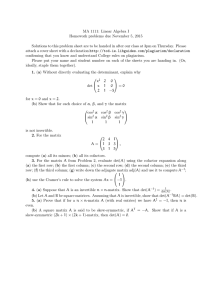Improved Construction for Universality of Determinant and Permanent
advertisement
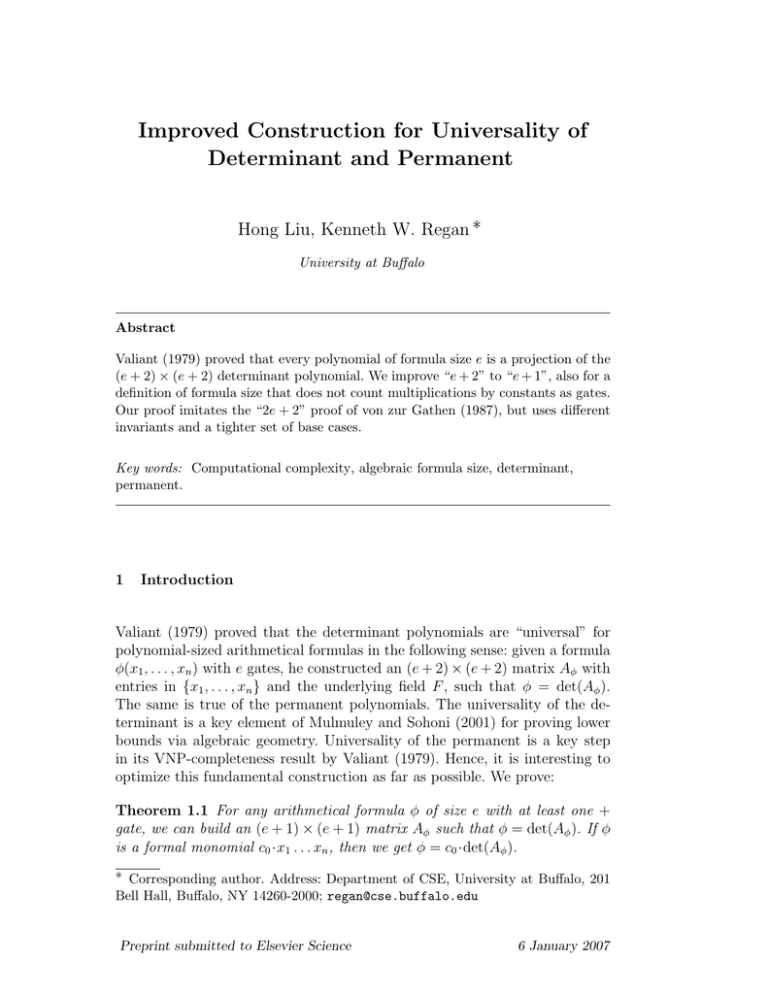
Improved Construction for Universality of
Determinant and Permanent
Hong Liu, Kenneth W. Regan ∗
University at Buffalo
Abstract
Valiant (1979) proved that every polynomial of formula size e is a projection of the
(e + 2) × (e + 2) determinant polynomial. We improve “e + 2” to “e + 1”, also for a
definition of formula size that does not count multiplications by constants as gates.
Our proof imitates the “2e + 2” proof of von zur Gathen (1987), but uses different
invariants and a tighter set of base cases.
Key words: Computational complexity, algebraic formula size, determinant,
permanent.
1
Introduction
Valiant (1979) proved that the determinant polynomials are “universal” for
polynomial-sized arithmetical formulas in the following sense: given a formula
φ(x1 , . . . , xn ) with e gates, he constructed an (e + 2) × (e + 2) matrix Aφ with
entries in {x1 , . . . , xn } and the underlying field F , such that φ = det(Aφ ).
The same is true of the permanent polynomials. The universality of the determinant is a key element of Mulmuley and Sohoni (2001) for proving lower
bounds via algebraic geometry. Universality of the permanent is a key step
in its VNP-completeness result by Valiant (1979). Hence, it is interesting to
optimize this fundamental construction as far as possible. We prove:
Theorem 1.1 For any arithmetical formula φ of size e with at least one +
gate, we can build an (e + 1) × (e + 1) matrix Aφ such that φ = det(Aφ ). If φ
is a formal monomial c0 ·x1 . . . xn , then we get φ = c0 ·det(Aφ ).
∗ Corresponding author. Address: Department of CSE, University at Buffalo, 201
Bell Hall, Buffalo, NY 14260-2000; regan@cse.buffalo.edu
Preprint submitted to Elsevier Science
6 January 2007
Besides moving e + 2 to e + 1, there is a second improvement; whereas the
formula size measure in Valiant (1979) counts multiplications by constant as
gates, ours does not. For example, 2wx + 3yz has size 5 in Valiant (1979) and
is taken to a 7 × 7 matrix. Here it has formula size 3 and is taken to a 4 × 4
matrix.
2
Definitions
We expand the formula definition in Valiant (1979) by adding coefficients to
the wires in circuits.
Definition 2.1 A formula φ over F is an expression that has one of the
following forms:
(1) a constant c ∈ F or a variable xi ; or
(2) c·φ where c is a constant and φ is a formula; or
(3) φ1 φ2 where φ1 and φ2 are formulas over F , and ∈ {+, ·}.
By applying 2 and 3, we can create c1 φ1 c2 φ2 , where c1 and c2 are regarded
as constants on the two wires leading into the gate.
Definition 2.2 We define formula size inductively as follows,
(1) If φ is a constant c or variable xi , then size(φ) = 0;
(2) If φ = c·φ0 for constant c and formula φ, then size(φ) = size(φ0 );
(3) If φ = φ1 φ2 for formulas φ1 , φ2 , then size(φ) = size(φ1 ) + size(φ2 ) + 1.
Thus, if size(φ1 ) = e1 and size(φ2 ) = e2 , then size(c1 φ1 + c2 φ2 ) = e1 + e2 + 1.
In Valiant (1979) and von zur Gathen (1987), however, the size would be
e1 + e2 + 3. Note that our size measure is one less than the numbers of leaves
in the formula tree of φ, ie., the number of occurrences of variables and additive
constants.
3
Proof of Main Theorem
Theorem 1.1 follows from the following statement, in which we carry a multiplicative constant c0 outside in all cases, and preserve additional invariants.
Theorem 3.1 For every formula φ of size e, there is an (e+1)×(e+1) matrix
Aφ and a constant c0 such that φ ≡ c0·det(Aφ ), and there exist A ∈ {X ∪F }e×e ,
α ∈ {X ∪ F }1×e , β ∈ {X ∪ F }e×1 such that A is upper triangular with −1 on
2
the main diagonal and Aφ is given by
α
−1
Aφ =
..
.
0
A
−1
a
.
β
(1)
The following properties are inductively maintained:
(1)
(2)
(3)
(4)
(5)
Every entry on the main sub-diagonal is −1.
All entries below the main sub-diagonal are 0.
Whenever φ has a ∗ gate, the entry a in the upper right corner is 0.
Whenever φ has a + gate, the last row has no variables.
Each column has at most one variable.
Proof. Theorem 1.1 now follows from property 4 since we can multiply the
last row by c0 . Our basis comprises all formulas that have no ∗ gates, and all
formulas that have no + gates:
(1) For a linear formula φ ≡
1 in place of xn ),
Pn
i=1
ai xi (the affine linear case is similar with
x x ... x
xn
n−1
1 2
−1
a1 /an
φ = an · −1
a2 /an
...
...
−1 an−1 /an
0
0
(2) For a monomial φ ≡ c0
Qn
i=1
.
(2)
xi ,
x1
−1 x2
.
φ = c0 · .. ..
. .
−1 xn 0
(3)
0
These formulas have size n − 1, and the matrices are n × n as required, with
conditions 1–5 holding. To prove equation (2), we need only expand the determinant by the first row; then the right-hand side of (2) equals
3
an ·(−1)1+n xn ·(−1)n−1 +
−1
0
a1 /an
.
..
...
0
−1
aj−1 /an
n−1
X
+
an ·(−1)1+j xj 0 . . . 0
aj /an
0 ... 0
j=1
−1
0 aj+1 /an
.
..
...
0
−1 an−1 /an
0
0
= an x n +
n−1
X
an ·(−1)1+j xj ·(−1)j+n−1 (aj /an )·(−1)n−2
j=1
=
n
X
aj xj = φ.
j=1
For monomial φ, equation (3) is clear. Note that the coefficient cannot be
brought inside any n × n matrix, so the exceptional constant c0 in Theorem
1.1 cannot be avoided. For example, c0 = c0 ·|1|, c0 x = c0 ·|x|, and
x
1 x1 x2 x1 0 a1 x+a2 = a1·
, a1 x1 +a2 x2 = a2·
, c0 x1 x2 = c0·
.
−1 a1 /a2 −1 a1 /a2 −1 x2 For the induction, note that if Theorem 3.1 holds for a formula φ, then for
any constant c, it holds for c · φ. So given φ of size e, assume the induction
hypothesis (IH) that, for any φ0 of size e0 < e, there exists an s0 × s0 matrix
A0φ such that for all clauses of Theorem 3.1 hold for φ0 and A0φ . There are two
top-level cases:
(1) Case 1: φ = φ1·φ2 . From IH, we get φ1 = c1·det(Aφ1 ) and φ2 = c2·det(Aφ2 ).
Similar to von zur Gathen (1987), we build the matrix Aφ by
Aφ =
Aφ1
0
4
0
−1
.
Aφ2
Then
φ = φ1 ·φ2 = c1 det(Aφ1 )·c2 det(Aφ2 ) = c1 ·c2 ·det(Aφ ).
The size s equals s1 + s2 = e1 + 1 + e2 + 1 = e + 1. If φ has a + gate,
we may wlog. suppose φ2 has a + gate, so that last row of Aφ2 and hence
the last row of Aφ has no variables. Then the properties 1–5 of Theorem
3.1 are clear.
(2) Case 2: φ = φ1 + φ2 . We will consider the following subcases,
(a) If φ1 and φ2 both have ∗ gates, we modify von zur Gathen (1987)’s
method as follows. According to IH, Aφk is as shown in equation (4)
for k = 1, 2.
Aφk
αk
−1
= ck ·
..
.
0
Ak
−1
0
.
βk
(4)
We build the s × s matrix Aφ by
α2
α1
−1
A1
.
..
0
−1
Aφ =
−1
A2
..
.
0
−1
0
0
0
0
0
β1
0
0
0
.
β2
(5)
−c2 c1
Besides having −1s not +1s on the main subdiagonal, the chief
difference from von zur Gathen (1987) is staggering β1 and β2 rather
than having one atop of the other. We show that this staggering introduces no unwanted nonzero diagonal products, and that the signs
of all products come out right. Now we prove that φ = det(Aφ ). In
(5), we expand the determinant by the last row, getting
det(Aφ ) = c1 ·det(R1 ) + (−1)(−c2 )·det(R2 ),
5
where
α1
α2
A1
−1
.
..
R1 =
0
−1
−1
..
.
0
0
0
0
β1
A2
0
(6)
−1
and
α1
α2
A1
−1
.
..
R2 = 0
−1
−1
...
0
0
0
0
0
.
A2
β2
(7)
−1
To prove det(R1 ) = det(Aφ1 ), we just flip the last column with the
second last column, then flip the second last with the third last, so
on and so forth. After s2 − 1 flips, we get a new matrix R1 as follows,
α1
0
α2
A1
−1
...
β1
R10 =
0
−1
−1
...
0
0
0
0
.
A2
(8)
−1
Therefore
det(R1 ) = (−1)s2 −1 det(R10 ) = (−1)s2 −1 (−1)s2 −1·det(Aφ1 ) = det(Aφ1 ).
Similarly, we can prove that det(R2 ) = det(Aφ2 ), and so
det(Aφ ) = det(Aφ1 ) + det(Aφ2 ).
6
At last, if we take outside the constant c2 from the last row of Aφ ,
we prove that properties 1–5 of Theorem 3.1 hold in this case.
(b) If one of φ1 and φ2 does not have a ∗ gate, wlog. suppose φ2 does
not have one, then φ2 is an affine formula, and we can express as
φ2 = φ02 + aw (where aw is an atom). Then
φ = φ1 + φ2 = φ1 + φ02 + aw.
So if we set φ0 = φ1 + φ02 , then φ = φ0 + aw. From IH, there exists a
matrix Aφ0 with submatrix A0 as in Theorem 3.1, giving
−1
0
φ = c0 ·det
..
.
Thus
α
A0
0
−1
α
0
−1
A0
...
φ = a·det
β
0
−1
0
0
.
β
(9)
w
0
.
(10)
−1 c0 /a
In equation (10), we flip the last two columns, and take out constant
−c0 /a from the last row, and we get:
α
−1
A0
...
φ = c0 ·det
0
−1
0
w
0
0
β
.
(11)
−1 a/c0
From (11), we have established properties 1–5 of Theorem 3.1. As remarked
above, this also finishes the proof of Theorem 1.1.
2
For the universality of the permanent polynomials, we have the following corollary.
Corollary 3.2 For any arithmetical formula φ of size e with at least one +
gate, we can build an (e + 1) × (e + 1) matrix Aφ such that s = e + 1 and
φ = per(Aφ ). If φ is a formal monomial a·xi . . . xn , then we get φ = a·per(Aφ ).
7
Proof. The only change to the proof of Theorem 1.1 is that property (1) now
reads, “Every entry on the main sub-diagonal is +1”—instead of −1 as for
the determinant. This works because the proof Theorem 3.1 does not rely on
cancellations—the −1s are solely to make odd permutations contribute terms
with the correct sign.
2
4
Examples and Conclusions
According to the method in von zur Gathen (1987), the matrix size se for
circuit size e obeys the recursive relation
se = si + sj , for anye = i + j + 1.
von zur Gathen (1987) takes s0 = 2 as basis, and hence gets se = e + 2, but
our more-extensive treatment of base-case formulas allows s0 = 1 and gives us
se = e + 1. For example, Valiant (1979) gets a 3 × 3 matrix for the formula
“5x”, while we get a 1 × 1 matrix with outside constant 5.
Clearly, “e+1” is optimal, if one requires each column to have at most one variable. Without this requirement, can one do better with a still more extensive
set of base cases? The answer is no in general, because when φ = x1 ·x2 ·· · ··xn
or φ = x1 + x2 + · · · + xn , then e + 1 is absolutely optimal. However, for
φ = 2wx + 3yz, we can get the 3 × 3 matrix
2x 3y 0
−1 0 w .
0 −1 z
This “cheats” a little by allowing “atoms” such as 2x and 3y as individual entries, but significantly, it has fewer columns than variables. Note that some formulas allow colossal savings in row/column size, such as the standard formulas
for the permanent and determinant themselves. Finding general cases allowing
s × s matrices with s = o(e) is a step for further research. Two such cases are
suggestive: For a family of formulas φn = x1 yn + x2 yn−1 + x3 yn−2 + · · · + xn y1 ,
φn has size en = 2n − 1, and we build a matrix Aφn as follows,
8
x1 x2 . . . x n
−1
=
−1
...
0
Aφn
0
0
yn
...
.
(12)
y2
−1 y1
We have φn = det(Aφn ), and matrix size sn = n + 1. Hence, limn→∞ sn /en =
1/2. We can find a more compressible family of formulas φn with determinant
polynomials Aφn as follows,
Aφn
x
x
11 12
−1 x
22
−1
=
. . . x1,n−1
. . . x2,n−1
. . . x3,n−1
..
.
...
x1n
x2n
x3n
.
(13)
...
xn−1,n−1 xn−1,n
0
−1
xnn
With φn = det(Aφn ), we have formula size en ≥ n(n + 1)/2, and matrix size
sn = n. Therefore,
√
lim sn ≤ 2en .
n→∞
References
Mulmuley, K., Sohoni, M., 2001. Geometric complexity theory, P vs. NP, and
explicit obstructions. In: Proceedings, International Conference on Algebra
and Geometry, Hyderabad, 2001.
Valiant, L., 1979. Completeness classes in algebra. In: Proc. 11th Annual ACM
Symposium on the Theory of Computing. Atlanta GA, pp. 249–261.
von zur Gathen, J., 1987. Feasible arithmetic computations: Valiant’s hypothesis. Journal of Symbolic Computation 4, 137–172.
9
